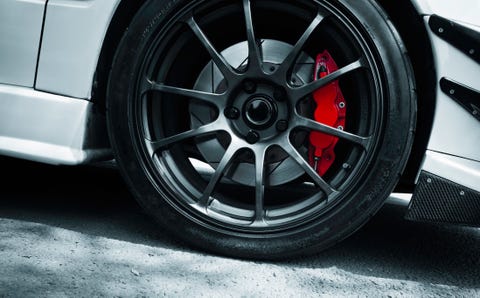Modern brakes use a cast-iron disc squeezed between two brake pads lined with friction material
Squeaky brakes are a serious automotive annoyance. But are squeaking brakes dangerous? How much does it cost to fix them? We’ve got your answers right here.
What Causes Breaks to Squeak?
Don’t expect brakes to be totally quiet sometimes, they’re going to make some noises. Don’t panic, because a squeaky brake can stop a car just like a silent one can.
What causes the squeal? Modern brakes use a cast-iron disc squeezed between two brake pads lined with friction material. Under the right conditions, the disc, the pads and the caliper they’re mounted in can start to vibrate in exactly the same way a violin’s string vibrates when stroked by the horsehairs on the bow. Most brake squeals occur at a single discrete frequency. The speed of the vehicle and how hard you press down on the left pedal will only change the volume of noise, because the pitch is controlled by the stiffness and mass of the pad and disc.
Inadequate development at the manufacturer that leaves brake systems prone to noise can usually be overcome by a Saturday mechanic without totally re-engineering the caliper/mount/pad/disc system. We can try to damp out the noise, or simply change the resonant frequency of the whole arrangement until it stops singing in any audible frequency.
Here’s how.
Normal Brake Pad Noises
In the past, brake pad friction material relied heavily on asbestos. Unfortunately, asbestos tended to give asbestos workers and brake mechanics lung cancer, so the industry has almost completely changed over to less dangerous alternatives. Kevlar is one material that’s seen a lot of use, but it tends to be dusty. Improved brake performance is more important nowadays because of increased safety requirements and equipment—and the extra road-hugging weight that comes along with these. That leads to the increased use of metallics and ceramics in the brake pad friction material. And this stuff can make the brakes hiss or even grind a little as you slow down. It’s a small price to pay for increased performance. So all pad noise is fine, right? Hold up there, Sparky, there’s one brake noise you need to pay attention to right away.
Many brake pads have a small finger of spring steel that will scrape on the disc as the pad reaches its wear limit. This tells you that it’s time to change pads for fresh, thicker ones before the friction material wears completely away, and you’re trying to slow down on the metal backing plates. It’s a sound not easily confused with brake squeal—it’s more of a ripping-sheet-metal noise, not a single, high-pitched note.
Stop the Squeak
Go into any auto parts store and you’ll see a shelf full of potions and widgets claiming to cure squeaks. One class of products I’m leery of is simple aerosols that you spray onto the pad’s friction material. I have no idea if they actually make the squeak go away, because I’m unwilling to try anything that changes the friction characteristics of the pad. Let’s not forget, the first reason your brake system exists is, in fact, to make your car slow down. Anything that could reduce that system’s effectiveness in any way is probably not a good idea.
Still got noise? Or still have plenty of pad material remaining and don’t want to drop fifty or a hundred bucks on a fresh set? You may be able to decouple the piston acoustically from the pad by purchasing shims made of Teflon, which are intended to go between the pad and the caliper’s hydraulic piston. I’ve tried those shims with middling success—sometimes they work and sometimes they don’t. Warning: Some calipers will not have enough extra travel in the piston bore to allow any shimming without making the brakes drag, at least with fresh, unworn pads.
You can achieve a similar decoupling without Teflon shims by simply coating the back face of the pad’s backing plates with high-temp brake grease or even anti-seize compound. Unlike shims, this tweak won’t last forever, as water and road dirt will wash it away eventually.
We chose high-end ceramic-based pads for our brake job, hoping the different friction characteristics would cure the squeal. Surprise, the new pads came out of the box fitted with Teflon-coated shims already installed.
A Sticky Solution
The favorite tweak for squeaks relies on a different principle: Instead of using shims or lubricants to decouple the pad from the caliper, stick the backing plate to the piston or caliper housing, effectively making its mass far larger. That will move the system’s resonant frequency out of the range that squeals. A smear of Super Glue won’t do it: You need something that will withstand the water, salt, filth and especially the heat that cars see in hard everyday use. How hot do brake systems get? I’ve seen brake discs glowing bright orange at the bottom of Pikes Peak, and flames shooting out of the brake drums of trucks descending Donner Pass. I’ve seen the brakes on my own race car visibly glow right after a few hot laps.
Whenever you’re installing any brake parts, be sure you remove any corrosion or road dirt from the mating parts—the brake pad or caliper housing needs to be able to slide in and out to compensate for wear. Clean up any sliding parts, which may require a wire brush or a file, until you can push the pads in and out with your bare hands. I prefer to replace any brake hardware (especially on drum brakes) that isn’t in perfect condition—hey, it’s cheap insurance. Apply a thin film of high-temp brake grease to any sliding surfaces. Obviously, avoid getting anything like grease or anti-seize on the pad or disc, and clean any greasy handprints off the disc surface before you hang the wheel on too.



